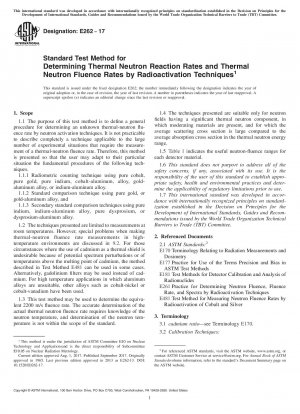ASTM E262-17
Standard Test Method for Determining Thermal Neutron Reaction Rates and Thermal Neutron Fluence Rates by Radioactivation Techniques
- Standard No.
- ASTM E262-17
- Release Date
- 2017
- Published By
- American Society for Testing and Materials (ASTM)
- Latest
- ASTM E262-17
- Scope
- 1.1 The purpose of this test method is to define a general procedure for determining an unknown thermal-neutron fluence rate by neutron activation techniques. It is not practicable to describe completely a technique applicable to the large number of experimental situations that require the measurement of a thermal-neutron fluence rate. Therefore, this method is presented so that the user may adapt to their particular situation the fundamental procedures of the following techniques. 1.1.1 Radiometric counting technique using pure cobalt, pure gold, pure indium, cobalt-aluminum, alloy, goldaluminum alloy, or indium-aluminum alloy. 1.1.2 Standard comparison technique using pure gold, or gold-aluminum alloy, and 1.1.3 Secondary standard comparison techniques using pure indium, indium-aluminum alloy, pure dysprosium, or dysprosium-aluminum alloy. 1.2 The techniques presented are limited to measurements at room temperatures. However, special problems when making thermal-neutron fluence rate measurements in hightemperature environments are discussed in 9.2. For those circumstances where the use of cadmium as a thermal shield is undesirable because of potential spectrum perturbations or of temperatures above the melting point of cadmium, the method described in Test Method E481 can be used in some cases. Alternatively, gadolinium filters may be used instead of cadmium. For high temperature applications in which aluminum alloys are unsuitable, other alloys such as cobalt-nickel or cobalt-vanadium have been used. 1.3 This test method may be used to determine the equivalent 2200 m/s fluence rate. The accurate determination of the actual thermal neutron fluence rate requires knowledge of the neutron temperature, and determination of the neutron temperature is not within the scope of the standard. 1.4 The techniques presented are suitable only for neutron fields having a significant thermal neutron component, in which moderating materials are present, and for which the average scattering cross section is large compared to the average absorption cross section in the thermal neutron energy range. 1.5 Table 1 indicates the useful neutron-fluence ranges for each detector material. 1.6 This standard does not purport to address all of the safety concerns, if any, associated with its use. It is the responsibility of the user of this standard to establish appropriate safety, health and environmental practices and determine the applicability of regulatory limitations prior to use. 1.7 This international standard was developed in accordance with internationally recognized principles on standardization established in the Decision on Principles for the Development of International Standards, Guides and Recommendations issued by the World Trade Organization Technical Barriers to Trade (TBT) Committee.
ASTM E262-17 Referenced Document
- ASTM E170 Standard Terminology Relating to Radiation Measurements and Dosimetry
- ASTM E177 Standard Practice for Use of the Terms Precision and Bias in ASTM Test Methods
- ASTM E181 Standard Test Methods for Detector Calibration and Analysis of Radionuclides
- ASTM E261 Standard Practice for Determining Neutron Fluence, Fluence Rate, and Spectra by Radioactivation Techniques
- ASTM E481 Standard Test Method for Measuring Neutron Fluence Rate by Radioactivation of Cobalt and Silver
ASTM E262-17 history
- 2017 ASTM E262-17 Standard Test Method for Determining Thermal Neutron Reaction Rates and Thermal Neutron Fluence Rates by Radioactivation Techniques
- 2013 ASTM E262-13 Standard Test Method for Determining Thermal Neutron Reaction Rates and Thermal Neutron Fluence Rates by Radioactivation Techniques
- 2008 ASTM E262-08 Standard Test Method for Determining Thermal Neutron Reaction Rates and Thermal Neutron Fluence Rates by Radioactivation Techniques
- 2003 ASTM E262-03 Standard Method for Determining Thermal Neutron Reaction and Fluence Rates by Radioactivation Techniques
- 1997 ASTM E262-97 Standard Method for Determining Thermal Neutron Reaction and Fluence Rates by Radioactivation Techniques
